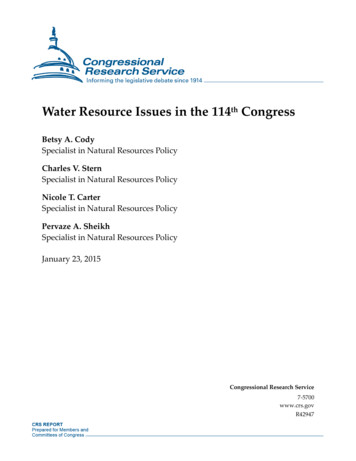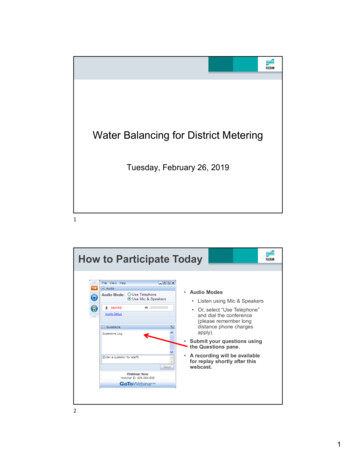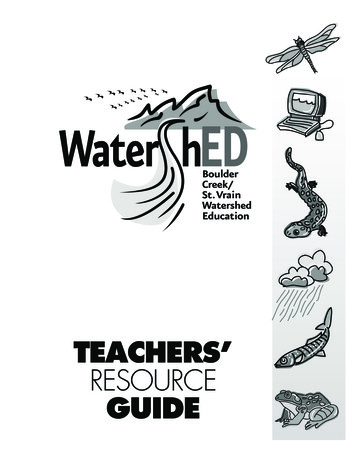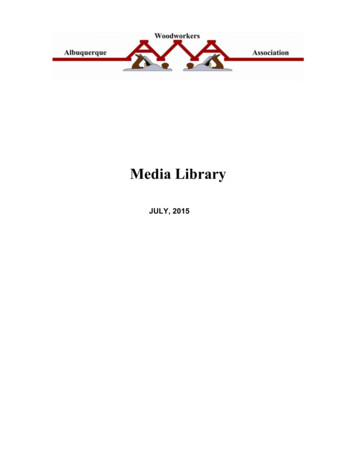
Transcription
Water Resource Issues in the 114th CongressBetsy A. CodySpecialist in Natural Resources PolicyCharles V. SternSpecialist in Natural Resources PolicyNicole T. CarterSpecialist in Natural Resources PolicyPervaze A. SheikhSpecialist in Natural Resources PolicyJanuary 23, 2015Congressional Research Service7-5700www.crs.govR42947
Water Resource Issues in the 114th CongressSummaryThe 114th Congress faces many water resource development, management, and protection issues.Congressional actions shape reinvestment in aging federal infrastructure (e.g., dams, locks, andlevees) and federal and nonfederal investment in new infrastructure, such as water supplyaugmentation, hydropower projects, navigation improvements, and efforts to restore aquaticecosystems. These issues often arise at the regional or local levels, but often have a federalconnection. Ongoing issues include competition over water, drought and flood responses andpolicies, competitiveness and efficiency of U.S. harbors and waterways, and innovative andalternative financing approaches. The 114th Congress also may continue oversight of operationsof federal infrastructure during drought and low-flow conditions, past large-scale flooding issues(e.g., Hurricane Sandy, Hurricane Katrina, Missouri and Mississippi River floods), and balancinghydropower generation, recreational use, and protection of threatened and endangered species. Inaddition to oversight, each Congress also provides appropriations for major federal waterresource agencies, such as the U.S. Army Corps of Engineers (Corps) and the Bureau ofReclamation (Reclamation).The issues before the 114th Congress are in part shaped by what earlier Congresses chose to enactand consider. Measures considered but not enacted by the 113th Congress include Californiadrought legislation, various drought policy and water efficiency and conservation measures,regional restoration legislation (e.g., Klamath Basin, Great Lakes, Chesapeake Bay), actions toexpedite water storage projects and permits, settlement of Indian water rights claims, and a liftingof restrictions on firearms at Army Corps projects.Because of recent water conditions, disasters, or legal or agency developments, certain river basinissues are particularly likely to receive congressional attention during the 114th Congress. TheColumbia River, Missouri River, and Sacramento and San Joaquin River (Central Valley Project)basins fall into this category. Other potential topics of congressional interest include emergencydrought or flood legislation, private and public hydropower, water research and scienceinvestment and coordination, aging infrastructure, and environmental policy.The 113th Congress enacted an omnibus Corps authorization bill, the Water Resources Reformand Development Act of 2014 (WRRDA 2014, P.L. 113-121). In addition to authorizing newprograms (e.g., Water Infrastructure Finance and Innovation Act) and Corps construction projects,the legislation also established new processes that may shape how subsequent Corps projectauthorizations are identified. A Corps authorization bill is often considered by each Congress;enactment, however, has been less regular, with the most recent bills enacted in 2014, 2007, and2000. The 113th Congress also enacted legislation to facilitate small conduit hydropowerdevelopment (P.L. 113-23 and P.L. 113-24),This report discusses recent congressional activity and possible topics for the 114th Congress. Itprovides an overview of the federal role in water resources development, management, andprotection, with a focus on projects of the two major federal water resources agencies—Reclamation and the U.S. Army Corps—and related legislation. It also discusses overarchingpolicy issues, such as drought and flood management and response, project funding andauthorization priorities, and aquatic ecosystem restoration.Congressional Research Service
Water Resource Issues in the 114th CongressContentsIntroduction. 1Recent Congressional Activity and Looking Forward. 1Legislation Enacted in the 113th Congress . 1Legislation Considered, but Not Enacted, During the 113th Congress . 2Water Resource Considerations for the 114th Congress . 3Federal Role in Water Resources . 4Federal Water Resource Agencies. 5U.S. Army Corps of Engineers . 6Bureau of Reclamation . 7Overarching Policy Issues . 8Drought and Flood Preparedness and Response. 9Funding and Authorization Priorities . 10Aging Infrastructure . 10Changing Federal Partnerships. 11Earmarks and Project Funding & Authorizations. 11Aquatic Ecosystem Restoration . 12ContactsAuthor Contact Information. 12Acknowledgments . 12Congressional Research Service
Water Resource Issues in the 114th CongressIntroductionThe 114th Congress is likely to face numerous water resource issues as it conducts oversight anddeliberates on authorizations and appropriations related to federal water resource development,management, and protection. Such issues include how to make investment decisions in the face offiscal constraints; how to maintain and reinvest in an aging portfolio of federal infrastructure(e.g., dams, locks, and levees); how to effectively respond to and prepare for flood and droughtemergencies; and how to distribute investment between activities to meet new demands for watersupplies, navigation, flood management, and aquatic ecosystem restoration and protection. Theseissues often arise at the regional level, but have a federal connection. For example, Congress maybe faced with responding to various water related crises, such as extreme drought or floodingissues (e.g., California drought in 2014 and coastal flooding issues associated with HurricaneSandy or other storms). More broadly, Congress may be faced with addressing navigationchallenges due to drought-induced low river flows or floods, and addressing water supply needsof farm and urban communities while also protecting threatened and endangered species. Thecrux of many of these challenges is how to balance competing demands for water and rivermanagement, including how to cope with the growing budget limitations and the effect of federalproject operations on the environment.This report first discusses recent congressional activity and possible topics for the 114th Congress.Next it provides an overview of the federal role in water resources development, management,and protection, including a discussion of the two major federal water resources agencies—theU.S. Army Corps of Engineers (Corps) and the Bureau of Reclamation (Reclamation)—andrelated legislation. The report then provides an overview of overarching policy issues, includingflood and drought preparedness and response, project funding and authorization priorities, andaquatic ecosystem restoration.Recent Congressional Activity and Looking ForwardThe water resource issues of the 114th Congress are in part shaped by the actions of pastCongresses. Legislative activity often is specific to the federal water resource managementagencies, such as the U.S. Army Corps of Engineers in the Department of Defense and theDepartment of the Interior’s Bureau of Reclamation, or is specific to water use by particularsectors, such as energy, agriculture, navigation, recreation, and municipal and industrial use.Occasionally, Congress takes up broader water resource policy issues, such as coordination offederal water resource activities and programs. Legislation enacted for both the Corps andReclamation during the 113th Congress was less than in prior Congresses, in large part due tocongressional earmark policies; however, some broad legislation was enacted for both agencies.Legislation Enacted in the 113th CongressThe 113th Congress enacted an omnibus Corps authorization bill, the Water Resources Reformand Development Act of 2014 (WRRDA 2014, P.L. 113-121).1 Congress also included in separatelegislation (P.L. 113-295) a provision increasing the fuel tax on commercial barges on federal1For more information see CRS Report R43298, Water Resources Reform and Development Act of 2014: Comparisonof Select Provisions, by Nicole T. Carter et al.Congressional Research Service1
Water Resource Issues in the 114th Congressinland waterways.2 The 113th Congress also provided regular and supplemental appropriations forthe Corps to conduct its work and performed oversight on its flood and drought management andnavigation actions, among other activities. The 113th Congress also provided appropriations forReclamation to conduct its ongoing activities.3Energy and environmental policy also affect water resources management and development. Twobills intending to facilitate the development of nonfederal hydropower were enacted in the 113thCongress: a small conduit hydropower development bill to facilitate nonfederal hydropowerdevelopment at Reclamation facilities (P.L. 113-24) and a separate bill making alterations to theFederal Energy Regulatory Commission licensing process for certain projects (P.L. 113-23).Several provisions related to water management in California were included in enactment of theFY2014 Consolidated Appropriations Act (P.L. 113-76, H.R. 3547) in January 2014. Alsoincluded in P.L. 113-76 was a one-year extension of the CALFED authorization (Section 207),and reauthorization the Reclamation States Emergency Drought Relief Act of 1991 (extendedthrough 2017; Sec. 206). The 113th Congress also reauthorized the National Integrated DroughtInformation System (NIDIS, P.L. 113-86), which, among other research, produces variousDrought Monitor products.The 113th Congress also enacted a farm bill (P.L. 113-79).4 In addition to providing support forfarmers and crop production, farm bills provide support for agricultural water conservation andefficiency measures, conservation programs in priority watersheds, and groundwater protectionand recharge, as well as water resource and infrastructure needs associated with soil and waterconservation.5 The 2014 farm bill also amended and added to existing drought and flood disasterassistance for agricultural producers.6Legislation Considered, but Not Enacted, During the 113th CongressThe 113th Congress also considered but did not enact legislation to augment developed watersupplies (e.g., water storage, water reuse), settle Indian water rights claims, and provide directionfor individual water projects and facilities. Several bills also would have authorized variousregional aquatic ecosystem restoration efforts. These bills generally addressed issues related tothe construction of projects for water quality and habitat restoration, as well as governance andreporting for ongoing federal restoration actions.2The annual appropriations bill for the Corps and Reclamation is the Energy and Water Development Appropriationsbill; however, both agencies occasionally receive funding in emergency or other supplemental appropriations acts,particularly in response to natural disasters, such as floods, droughts, and hurricanes. For more information, see CRSReport R41430, Inland Waterways: Recent Proposals and Issues for Congress, by Charles V. Stern.3In the 113th Congress, the Corps received 5.3 billion in funding related to the landfall of Hurricane Sandy. For moreinformation, CRS Report R42841, Army Corps Supplemental Appropriations: Recent History, Trends, and PolicyIssues, by Charles V. Stern and Nicole T. Carter.4See CRS Report IF00014, The 2014 Farm Bill (Agricultural Act of 2014, P.L. 113-79) (In Focus), by Renée Johnsonand Jim Monke; and, CRS Report R43076, The 2014 Farm Bill (P.L. 113-79): Summary and Side-by-Side, coordinatedby Ralph M. Chite.5For more information on agricultural soil and water conservation programs, see CRS Report R43504, ConservationProvisions in the 2014 Farm Bill (P.L. 113-79), by Megan Stubbs.6For more information on agricultural disaster assistance programs, see CRS Report R43494, Crop InsuranceProvisions in the 2014 Farm Bill (P.L. 113-79), by Dennis A. Shields; CRS Report RS21212, Agricultural DisasterAssistance, by Dennis A. Shields; and CRS Report R42854, Emergency Assistance for Agricultural LandRehabilitation, by Megan Stubbs.Congressional Research Service2
Water Resource Issues in the 114th CongressSeveral bills related to aquatic ecosystem restoration throughout the country were considered inthe 113th Congress and were pending at its conclusion. These bills generally addressed issuesrelated to water quality and habitat restoration, as well as project construction for restoration andwater supply allocation among users and the environment. Bills authorizing comprehensiveecosystem restoration initiatives were introduced for the Great Lakes (e.g., H.R. 2773 and S.1232), Long Island Sound (H.R. 2174 and S. 1080), and Lake Tahoe (H.R. 3390 and S. 1451).These bills addressed governance of ecosystem restoration initiatives and the reauthorization offunding to continue restoration efforts, among other things. Other bills addressed specific aspectsof ongoing restoration initiatives, such as expediting restoration project approval in theEverglades ecosystem. H.R. 5764 did pass the House, but was not voted on in the Senate. H.R.5764 would have authorized the Great Lakes Restoration Initiative and 300 million inappropriations annually from FY2015 to FY2019.The 113th Congress also considered several different version of California drought legislation, aswell as other legislation to augment water supplies or deal with low water supplies on a broaderlevel. The House twice passed legislation aimed at addressing operation of the federal CentralValley Project (CVP) in California (H.R. 3964 and H.R. 5781) and the Senate also passedlegislation to address CVP operations in times of drought emergencies (S. 2198). However,House and Senate negotiators did not come to agreement on bill language prior to the end of the113th Congress. The 113th Congress also considered water research and development legislation targeted atspecific programs or issues, such as research related to desalination (e.g., H.R. 745) and statewater resources research institutes (S. 970). Similarly, the 113th Congress considered legislation(H.R. 5189 and S. 1971) to coordinate federal research and technologies to better understand anddecrease the risks from the interdependencies of the energy (e.g., water use for oil and gasproduction and power plant cooling) and water sectors (e.g., energy for water transport andtreatment).7Unlike the 112th Congress (H.R. 5862), the 113th Congress did not consider legislation addressingthe broad federal water science and research portfolio. Water science and research is spreadacross more than 20 federal agencies. No single water research strategy or formal coordination orprioritization mechanism exists. Some stakeholders are concerned that current research isinsufficient to prepare the United States to confront domestic and international water challenges.Water Resource Considerations for the 114th CongressThe 114th Congress may address some measures left pending at the end of the 113th Congress, andmay consider other proposals as well. Because of recent water conditions (e.g., drought inportions of the West and Southwest), disasters, or legal or agency developments, certain basinissues are likely to receive congressional attention. These include the operation of federalreservoirs on the Sacramento and San Joaquin rivers (Central Valley Project in California) and onthe Missouri River and its tributaries. Other river basins that may receive attention in the 114thCongress include the Colorado, Klamath, and Rio Grande river basins. Additionally, future7CRS Report R43199, Energy-Water Nexus: The Energy Sector’s Water Use, by Nicole T. Carter; CRS ReportR43200, Energy-Water Nexus: The Water Sector’s Energy Use, by Claudia Copeland.Congressional Research Service3
Water Resource Issues in the 114th Congressoperation of Corps facilities on the Columbia River and its tributaries is central to discussions thatare underway regarding modification of the Columbia River Treaty with Canada.8Because of recent drought conditions in California and much of the West, Congress might againaddress drought assistance, planning, and preparedness through oversight hearings and/orlegislation, including through Energy and Water Development Appropriations. (See Drought andFlood Preparedness and Response section below.)The 114th Congress may conduct oversight of restoration activities, including those in theChesapeake Bay, Everglades, Gulf Coast, Great Lakes, San Joaquin River, and Sacramento andSan Joaquin Rivers Delta and its confluence with San Francisco Bay (Bay-Delta). Commonthemes in regional restoration efforts include demand for new project services (e.g., improved ornew flood control, water supply, and navigation facilities), protection of threatened andendangered species, drought and flood management, and water quality concerns.The 114th Congress also may react to efforts by the Administration to implement updatedplanning guidance for federal water resources projects and to guide federal investment infloodplains. Similarly, Congress may respond to Administration-wide efforts to incorporateclimate change adaptation into agency plans and actions, including those being developed by theCorps and Reclamation. The 114th Congress also may engage in discussion of how threatened andendangered species designations and related critical habitat and environmental mitigationrequirements affect water resource project construction and operations.Federal Role in Water ResourcesThe federal government has long been involved in efforts to facilitate navigation, expandirrigation, and reduce flood and drought losses. For example, nearly every large river basin in thecountry—from the Columbia, Sacramento, and Colorado rivers in the West to the Missouri,Mississippi, and Delaware rivers—contains one or more federal dam or navigation projects.These projects have largely been constructed by the Corps and Reclamation. More recently,federal involvement has expanded to include municipal water supply development and efforts toprotect water-related resources such as fish and wildlife. Increasing pressures on the quality andquantity of available water supplies have resulted in heightened local and regional water useconflicts throughout the country, particularly in the West and Southeast. Pressures includepopulation growth, environmental regulation, in-stream species and ecosystem needs, watersource contamination, agricultural and energy water demands, climate change and variability, andchanging public interests, such as heightened demand for in-stream recreation.Congress historically has played a major role in water resources through authorization of andappropriations for regional and site-specific activities; however, numerous responsibilities aresplit or shared with state, local, and tribal governments, particularly related to water allocationand resource planning and management. Congress also establishes the policies that define thefederal role in planning for federal water resource projects, and provides direction forconstruction, maintenance, inspection, and support of federal projects. Congress makes thesedecisions within the context of multiple and often conflicting objectives, competing legaldecisions, long-established institutional mechanisms (e.g., century-old water rights, and8See CRS Report R43287, Columbia River Treaty Review, by Charles V. Stern.Congressional Research Service4
Water Resource Issues in the 114th Congresscontractual obligations), and in response to events such as floods, droughts, and structuralfailures.Federal water resource construction activities shrank during the last decades of the 20th century,marking the end of earlier expansionist policies that had supported large federal investments indams and hydropower facilities, navigation locks and channels, irrigation diversions, and floodcontrol levees, as well as basin-wide planning and development efforts. Fiscal constraints,changes in national priorities and local needs, few remaining prime construction locations, andenvironmental and species impacts of construction and operation of federal projects allcontributed to this shift. Although these forces are still active, there are proposals for renewedfederal financial and technical assistance to address growing pressures on developed watersupplies, to manage regional water resources to meet demands of multiple water uses, and toaddress the aging stock of water resources infrastructure.Recent drought conditions in the West and Southwest on top of extended and widespread droughtin 2012, coastal flooding due to Hurricane Sandy and Hurricane Katrina, and Midwest floods of2011 have raised other questions about the federal role in water resources. In particular, disastershave brought attention to the trade-offs in approaches to distributing federal appropriationsamong competing water resources projects, to risk management in water resources, and to thetrade-offs in benefits, costs, and risks of the current division of responsibilities among local, state,and federal entities.Federal Water Resource AgenciesMost of the large dams and water diversion structures in the United States were built by, or withthe assistance of, Reclamation or the Corps. Historically, Reclamation projects were designedprincipally to provide reliable supplies of water for irrigation and some municipal and industrialuses. Corps projects were planned principally to improve navigation and reduce flood damages,with power generation, water supply, and recreation being incidental benefits. Reclamationcurrently manages hundreds of dams and reservoirs in 17 western states,9 providing water toapproximately 10 million acres of farmland and 31 million people, as well as 58 power plantscapable of producing 40 billion kilowatt-hours of electricity annually (enough for approximately3.5 million homes), and which generate more than 1 billion in revenues annually.10 The Corpsoperates nationwide, and its activities are diverse. The Corps has constructed thousands of flooddamage reduction and navigation projects throughout the country, including nearly 12,000 milesof commercially active waterways, nearly 1,000 harbors, and 600 dam and reservoir projects(with 75 hydroelectric plants generating 68 billion kilowatt-hours annually). Additionally, theCorps constructed, usually with nonfederal participation, roughly 9,000 miles of the estimated100,000 miles of the nation’s levees, but the agency only maintains 900 miles. The remaininglevees are operated by nonfederal entities, often local governments or special districts.The Natural Resources Conservation Service (NRCS) in the U.S. Department of Agriculture alsofacilitates water resources development, primarily for flood control in small watersheds and for9Arizona, California, Colorado, Idaho, Kansas, Montana, Nebraska, Nevada, New Mexico, North Dakota, Oklahoma,Oregon, South Dakota, Texas, Utah, Washington, and Wyoming.10U.S. Department of the Interior, Budget Justifications and Performance Information Fiscal Year 2014, Bureau ofReclamation, Washington, DC, 2013, p. General Statement-2, http://www.usbr.gov/budget/.Congressional Research Service5
Water Resource Issues in the 114th Congresssoil and water conservation purposes. For more information on USDA conservation programs andpolicies, see CRS Report R40763, Agricultural Conservation: A Guide to Programs, by MeganStubbs.Many other federal agencies have water-related programs (e.g., the Environmental ProtectionAgency, the U.S. Geological Survey, the National Oceanographic and AtmosphericAdministration, National Aeronautics and Space Administration, Federal EmergencyManagement Agency, and energy-related agencies such as the Federal Energy RegulatoryCommission and Power Marketing Administrations). However, the remainder of this reportfocuses on the projects, programs, and policies of the Corps and Reclamation. For more information on federal water projects and programs—including typesof financing and financial assistance—see CRS Report RL30478, FederallySupported Water Supply and Wastewater Treatment Programs, coordinated byClaudia Copeland. For more information on other federal water activities, see CRS Report R42653,Selected Federal Water Activities: Agencies, Authorities, and CongressionalCommittees, by Betsy A. Cody et al.U.S. Army Corps of EngineersDuring most years, the Corps responds to needs arising from flood and drought events, as well asperforming its regular activities of constructing and operating and maintaining navigation, floodcontrol, and ecosystem restoration projects and issuing permits for activities that may affectnavigable waters and wetlands.11 As previously noted, Congress authorizes Corps water resourcesactivities and makes changes to the agency’s policies generally in an omnibus authorization bill,often titled as a Water Resources Development Act. Although WRDA enactment is usuallyattempted on a biennial schedule, enactment is less regular in part because of multiple andconflicting stakeholder interests and tensions over potential changes in Corps policies. Also, thebill is not a reauthorization bill, per se—rather, it is largely an authorization bill, since few Corpsauthorities expire.12 The most recent WRDAs were enacted in 2000, 2007, and 2014. Congresstypically appropriates funds for these activities in annual Energy and Water DevelopmentAppropriations acts, and at times, it uses supplemental appropriations bills to fund Corpsemergency activities.13Hurricane Sandy in 2012 and Midwest flooding in 2011 raised many questions that the 114thCongress may pursue, including those related to national flood risk and federal actions to reducethat risk. In many cases, Corps facilities and their operations are central to debates over multipurpose river management, especially during drought and flood conditions. For example,reservoir management by the Corps, such as in the Apalachicola-Chattahoochee-Flint basin11A discussion of the Corps regulatory programs is beyond the scope of this report. The most notable of the Corps’regulatory activities is associated with wetland protection. For more on wetlands issues, see CRS Report RL33483,Wetlands: An Overview of Issues, by Claudia Copeland.12While Corps authorizations generally do not expire or have established sunsets, an automatic de-authorizationprocess begins if projects have not received funding for five years. A number of projects that were authorized inWRDA 2007 (P.L. 110-114) may soon undergo this process.13For more on these topics, see CRS Report R42841, Army Corps Supplemental Appropriations: Recent History,Trends, and Policy Issues, by Charles V. Stern and Nicole T. Carter.Congressional Research Service6
Water Resource Issues in the 114th Congress(which provides much of the water supply for Atlanta, GA), is often controversial and has beenchallenged in the courts. Likewise, Corps operation of dams on the Missouri River and its effecton downstream navigation, flood control, species, and upstream water supplies remaincontroversial.Bureau of ReclamationSince the early 1900s, Reclamation has constructed and operated many large, multi-purpose waterprojects, such as Hoover Dam on the Colorado River and Grand Coulee Dam on the ColumbiaRiver. Water supplies from these projects have been primarily for irrigation; however, somemunicipalities also receive water from Reclamation projects. Many of the largest facilities alsoproduce hydropower. Construction authorizations slowed during the 1970s and 1980s due toseveral factors. In 1987, Reclamation announced a new mission recognizing the agency’stransition from a water resources development and construction organization to one primarilyoccupied with managing water resources, including managing water and related resources in anenvironmentally and economically sound manner.14 Since then, increased population, prolongeddrought, fiscal constraints, and water demands for fish and wildlife, recreation, and scenicenjoyment have resulted in increased pressure to alter operation of many Reclamation projects.Such changes have been controversial, however, as water rights, contractual obligations, and thepotential economic effects of altering project operations complicate any change in waterallocation, delivery, or project operations.In contrast to the Corps, there is n
Because of recent water conditions, disasters, or legal or agency developments, certain river basin issues are particularly likely to receive congressional attention during the 114th Congress. The Columbia River, Missouri River, and Sacramento and San Joaquin River (Central Valley Project) basins fall into this category.











